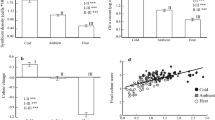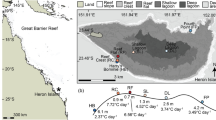Abstract
This study tested the effects of acclimatization on the response of corals to elevated temperature, using juvenile massive Porites spp. and branching P. irregularis from Moorea (W149°50′, S17°30′). During April and May 2006, corals were acclimatized for 15 days to cool (25.7°C) or ambient (27.7°C) temperature, under shaded (352 μmol photons m−2 s−1) or ambient (554 μmol photons m−2 s−1) natural light, and then incubated for 7 days at ambient or high temperature (31.1°C), under ambient light (659 μmol photons m−2 s−1). The response to acclimatization was assessed as biomass, maximum dark-adapted quantum yield of PSII (Fv/Fm), and growth, and the effect of the subsequent treatment was assessed as Fv/Fm and growth. Relative to the controls (i.e., ambient temperature/ambient light), massive Porites spp. responded to acclimatization through increases in biomass under ambient temperature/shade, and low temperature/ambient light, whereas P. irregularis responded through reduced growth under ambient temperature/shade, and low temperature/ambient light. Acclimatization affected the response to thermal stress for massive Porites spp. (but not P. irregularis), with an interaction between the acclimatization and subsequent treatments for growth. This interaction resulted from a lessening of the negative effects of high temperature after acclimatizing to ambient temperature/shade, but an accentuation of the effect after acclimatizing to low temperature/shade. It is possible that changes in biomass for massive Porites spp. are important in modulating the response to high temperature, with the taxonomic variation in this effect potentially resulting from differences in morphology. These results demonstrate that corals can acclimatize during short exposures to downward excursions in temperature and light, which subsequently affects their response to thermal stress. Moreover, even con-generic taxa differ in this capacity, which could affect coral community structure.



Similar content being viewed by others
References
Anthony KRN, Hoegh-Guldberg O (2003) Variation in coral photosynthesis, respiration and growth characteristics in contrasting light microhabitats: an analogue to plants in forest gaps and understoreys? Funct Ecol 17:246–259
Anthony KRN, Connolly SR, Willis BL (2002) Comparative analysis of energy allocation to tissue and skeletal growth in corals. Limnol Oceangr 47:1417–1429
Baker AC (2004) Symbiont diversity on coral reefs and relationship to bleaching resistance. In: Rosenberg E, Loya Y (eds) Coral health and diseases. Springer, Berlin, pp 177–194
Berkelmans R, Willis BL (1999) Seasonal and local spatial patterns in the upper thermal limits of corals on the inshore central Great Barrier Reef. Coral Reefs 18:219–228
Bowler K (2005) Acclimation, heat shock and hardening. J Therm Biol 30:125–130
Brown BE, Dunne RP, Ambarsari I, Le Tissier MDA, Satapoomin U (1999) Seasonal fluctuations in environmental factors and variations in symbiotic algae and chlorophyll pigments in four Indo-Pacific coral species. Mar Ecol Prog Ser 191:53–69
Brown BE, Dunne RP, Goodson MS, Douglas AE (2002) Experience shapes the susceptibility of a reef coral to bleaching. Coral Reefs 21:119–126
Buddemeier RW, Kinzie RA (1976) Coral growth. Ocean Mar Biol Ann Rev 14:183–225
Buddemeier RW, Baker AC, Fautin DG, Jacobs JB (2004) The adaptive hypothesis of bleaching. In: Rosenberg E, Loya Y (eds) Coral health and diseases. Springer, Berlin, pp 1427–1444
Castillo KD, Helmuth BST (2005) Influence of thermal history on the response of Montastraea annularis to short-term temperature exposure. Mar Biol 148:261–270
Coles SL, Brown BE (2003) Coral bleaching—capacity for acclimatization and adaptation. Adv Mar Biol 46:183–223
Coles SL, Jokiel PL (1977) Effects of temperature on photosynthesis and respiration in hermatypic corals. Mar Biol 43:209–216
Coles SL, Jokiel PL (1978) Synergistic effects of temperature, salinity and light on the hermatypic coral Montipora verrucosa. Mar Biol 49:187–195
Dana JD (1846) Zoophytes. US Explor Exped 1838–1842 7:1–740
Davies PS (1989) Short-term growth measurements of corals using an accurate buoyant weighing technique. Mar Biol 101:389–395
Day TL, Nagel L, van Oppen MJH, Caley MJ (2008) Factors affecting the evolution of bleaching resistance in corals. Am Nat 171:72–88
Dove SG, Hoegh-Guldberg O (2006) The cell physiology of coral bleaching. In: Kleypas J, Skirving W, Strong A (eds) Coral reefs and climate change: science and management. American Geophysical Union, Washington, pp 55–71
Edmunds PJ (2004) Juvenile coral populations track rising seawater temperature on a Caribbean reef. Mar Ecol Prog Ser 269:111–119
Edmunds PJ (2005) The effect of sub-lethal increases in temperature on the growth and population trajectories of three scleractinian corals on the southern Great Barrier Reef. Oecologia 146:350–364
Edmunds PJ (2006) Temperature- mediated transitions between isometry and allometry in a colonial, modular invertebrate. Proc R Soc B 273:2275–2281
Edmunds PJ (2008) The effects of temperature on the growth of juvenile scleractinian corals. Mar Biol 154:153–162
Edmunds PJ, Gates RD (2008) Acclimatization in tropical reef corals. Mar Ecol Prog Ser 361:307–310
Edmunds PJ, Spencer-Daves P (1986) An energy budget for Porites porites (Scleractinia). Mar Biol 92:339–347
Edwards H, Haime JM (1860) Histoire naturelle des Coralliaires. Librairie Encyclopédique de Roret, Paris, vol 1, 2, 3, pp 1–326, 1–632, 1–560
Falkowski PG, Dubinsky Z (1981) Light-shade adaptation of Stylophora pistillata, a hermatypic coral from the Gulf of Eilat. Nature 289:172–174
Fitt WK, McFarland FK, Warner ME, Chilcoat GC (2000) Seasonal patterns of tissue biomass and densities of symbiotic dinoflagellates in reef corals and relation to coral bleaching. Limnol Oceanogr 45:677–685
Forskål P (1775) Descriptiones Animalium, Avium, Amphibiorium, Piscium, Insectorum, Vermium que in intinere orientali observavit Petrus Forskål. IV Corallia. Hauniae, pp 131–139
Gates RD, Edmunds PJ (1999) The physiological mechanisms of acclimatization in tropical reef corals. Am Zool 39:30–43
Gorbunov MY, Kolber SZ, Lesser MP, Falkowski PG (2001) Photosynthesis and photoprotection in symbiotic corals. Limnol Oceanogr 46:75–85
Gould SJ, Lloyd EA (1997) Individuality and adaptation across levels of selection: how shall we name and generalize the unit of Darwinism? Proc Natl Acad Sci USA 96:11904–11909
Grottoli AG, Rodrigues LJ, Palardy JE (2006) Heterotrophic plasticity and resilience in bleached corals. Nature 440:1186–1189
Hazel JR (1995) Thermal adaptation in biological membranes: is homeoviscous adaptation the explanation? Annu Rev Physiol 57:19–42
Hoegh-Guldberg OM, Fine M, Skirving W, Johnson R, Dove S, Strong A (2005) Coral bleaching following wintry weather. Limnol Oceanogr 50:265–271
Hurlbert SH (1984) Pseudoreplication and the design of ecological field experiments. Ecol Monogr 54:187–211
Iglesias-Prieto R, Matta JL, Robins WA, Trench RK (1992) Photosynthetic response to elevated temperature in the symbiotic dinoflagellate Symbiodinium microadriaticum in culture. Proc Natl Acad Sci USA 89:10302–10305
Jokiel PL (2004) Temperature stress and coral bleaching. In: Rosenberg E, Loya Y (eds) Coral health and diseases. Springer, Berlin, pp 401–425
Jokiel PL, Coles SL (1977) Effects of temperature on the mortality and growth of Hawaiin reef corals. Mar Biol 43:201–208
Jones RJ, Hoegh-Guldberg O, Larkum AWD, Scheiber U (1998) Temperature-induced bleaching of corals begins with impairment of the CO2 fixation mechanism in zooxanthellae. Plant Cell Environ 21:1219–1230
Jones AM, Berkelmans R, van Oppen MJH, Mieog JC, Sinclair W (2008) A community change in the algal endosymbionts of a scleractinian coral following a natural bleaching event: field evidence of acclimatization. Proc R Soc B 275:1359–1365
Leichter JJ, Helmuth BST, Fisher AM (2006) Variation beneath the surface: quantifying complex thermal environments on coral reefs in the Caribbean, Bahamas and Florida. J Mar Res 64:563–588
Levy O, Mizrah L, Chadwick-Furman NE, Achituv Y (2001) Factors controlling the expansion behavior of Favia favus (Cnidaria: Scleractinia): effects of light, flow, and planktonic prey. Biol Bull 200:118–126
Link HT (1807) Beschreibung der Naturalien Sammlungen der Universitat zu Rostock 3:161–165
Marsh JA (1970) Primary productivity of reef-building calcareous red algae. Ecology 51:255–263
Maxwell K, Johnson GN (2000) Chlorophyll fluorescence—a practical guide. J Exp Bot 51:659–668
Middlebrook R, Hoegh-Guldberg O, Leggat W (2008) The effect of thermal history on the susceptibility of reef-building corals to thermal stress. J Exp Biol 211:1050–1056
Mumby PJ, Chisholm JRM, Edwards AJ, Andrefout S, Jaubert J (2001) Cloudy weather may have saved Society Island coral reefs during the 1998 ENSO event. Mar Ecol Prog Ser 222:209–216
Muscatine L, Grossman D, Doino J (1991) Release of symbiotic algae by tropical sea anemones and corals after cold shock. Mar Ecol Prog Ser 77:233–243
Nakamura T, van Woesik R (2001) Water-flow rates and passive diffusion partially explain differential survival of corals during the 1998 bleaching event. Mar Ecol Prog Ser 212:301–304
Porter JW, Lewis SK, Porter KG (1999) The effects of multiple stressors on the Florida Keys coral reef ecosystem: a landscape hypothesis and a physiological test. Limnol Oceanogr 44:941–949
Quelch JJ (1884) Preliminary notice of new genera and species of Challenger reef corals. Ann Mag Nat Hist 13:292–297
Quinn GP, Keough MJ (2003) Experimental design and data analysis for biologists. Cambridge University Press, Cambridge
Rohwer F, Seguritan V, Azam F, Knowlton N (2002) Diversity and distribution of coral-associated bacteria. Mar Ecol Prog Ser 243:1–10
Suwa R, Hirosa M, Hidaka M (2008) Seasonal fluctuation in zooxanthellar genotype composition and photophysiology in the corals Pavona divaricata and P. decussata. Mar Ecol Prog Ser 361:129–137
Tchernov D, Gorbunov MY, Vargas C, Yadav SN, Milligan AJ, Haggblom M, Falkowski PG (2004) Membrane lipids of symbiotic algae are diagnostic of sensitivity to thermal bleaching in corals. Proc Natl Acad Sci USA 101:13531–13535
Vaughan TW (1918) Some shoal-water corals from Murray Islands, Cocos-Keeling Islands and Fanning Island. Pap Dept Mar Biol Carnegie Inst Wash 9:51–243
Warner ME, Fitt WK, Schmidt GW (1999) Damage to photosystem II in symbiotic dinoflagellates: a determinant of coral bleaching. Proc Natl Acad Sci USA 96:8007–8012
Warner ME, Chilcoat GC, McFarland FK, Fitt WK (2002) Seasonal fluctuations in the photosynthetic capacity of photosystem II in symbiotic dinoflagellates in the Caribbean reef-building coral Montastraea. Mar Biol 141:31–38
Wethey DS, Porter JW (1976) Sun and shade differences in productivity of reef corals. Nature 262:281–282
Yellowlees D, Rees TAV, Leggat W (2008) Metabolic interactions between algal symbionts and invertebrate hosts. Plant Cell Environ 31:679–694
Acknowledgments
This research was supported by grant OCE 04-17412 from the National Science Foundation and gifts from the Gordon and Betty Moore Foundation, and was completed under a permit from the French Polynesian Ministry of Research. I am grateful to N. Davies and the staff of the UC Berkeley, Richard B. Gump South Pacific Research Station for making my visit to Moorea productive and enjoyable, M. Murray for field support, and my graduate students N. Muehllehner and H. Putnam for help in multiple aspects of this project. This is a contribution of the Moorea Coral Reef (MCR) LTER Site, and is contribution number 151 of the Marine Biology Program of California State University, Northridge.
Author information
Authors and Affiliations
Corresponding author
Additional information
Communicated by J. P. Grassle.
Electronic supplementary material
Below is the link to the electronic supplementary material.
Rights and permissions
About this article
Cite this article
Edmunds, P.J. Effect of acclimatization to low temperature and reduced light on the response of reef corals to elevated temperature. Mar Biol 156, 1797–1808 (2009). https://doi.org/10.1007/s00227-009-1213-2
Received:
Accepted:
Published:
Issue Date:
DOI: https://doi.org/10.1007/s00227-009-1213-2




